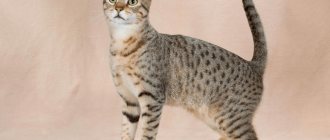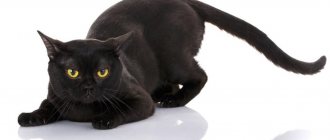The Sphynx cat has an unusual appearance because this animal has no fur at all. Because of this feature, the cat requires special care and maintenance so that everything is always in good health. It is important to raise your pet correctly. From birth to 2-3 months, this responsibility lies with the kitten’s mother; then the owner needs to pay attention to the pet, train it and teach it proper manners.
Breed and its characteristics
Despite their unusual alien appearance, it is impossible not to admire Sphynx cats. This animal differs from its other relatives in that there is almost no fur on its body. That is why it is important to properly care for your pet’s skin and health, trying to create the most comfortable conditions for living and full development.
Both the adult and the small Sphynx are distinguished by their friendly, affectionate, flexible character. Cats love outdoor games and actively participate in everything their owners do. It is easy to raise and potty train a Sphynx, as the animal has a very developed intelligence. Animals never shit anywhere, they are clean and cannot stand a place where it is not cleaned.
The Animal Planet channel compiled a rating of the smartest varieties of cats, and sphinxes in this competition took first place of honor for their intelligence, quick wit, and strong love for their owner and his children.
The main indicator is age
A kitten is a child with fur and a tail, which means it needs to be treated as such. Raising little kittens is always associated with pranks, disobedience, and later with rebellions of adolescence. Before you start training your pet, you need to assess its physical and psychological age.
From birth to 2 months, kittens are under the care of their mother. Kids actively communicate with each other and learn to build relationships. Essentially, at this stage, the quadruped goes through a process of basic socialization. Children have their first conflicts, and they resolve them as best they can; some fight, others silently retreat. At this age, kittens do not yet fully control their own bodies, but every day they become more and more confident in themselves and their abilities.
If you become the parent of an orphaned kitten, then the main task becomes survival. Feeding such a baby is not easy. The kitten needs to be bottle-fed every 2-4 hours, warmed and protected. A separate topic is the correct choice of food products, since whole and store-bought cow’s milk is not suitable for babies. The best choice is powdered cat milk replacer. You will have to massage your baby's stomach and genital area with a warm, damp cloth, otherwise he simply will not be able to go to the toilet.
Important! If you do not have experience in feeding blind kittens, do not take risks and consult a veterinarian.
As soon as the baby has opened his eyes, mastered complementary feeding and confidently stood on his paws, he can prepare to move to a new home. At this age, the main aspect is a complete and balanced diet. However, the kitten will face a lot of stress - moving, change of owner, environment and daily routine. Try to smooth out the baby’s experiences as much as possible, maintain the usual daily routine and food intake, take from the breeder or curator some of the bedding that will smell (for a while) of the mother.
Next, you will watch your ward grow up, not by months, but by days. The baby will begin to master running, jumping and other tasks that are difficult for his age. The kitten will realize that he is quite strong and will begin to climb all kinds of surfaces. Around this age, you need to start raising your baby, but the main attention should be paid to his safety. The baby may already understand the importance of boundaries, so try to isolate the kitten in a room, house or carrier for the period of time until you can monitor it.
Important! If you decide to train your kitten to be carried, start with a 2-3 minute period and increase it gradually. Stay close to the carrier and continue to soothe your baby.
It is necessary to pay special attention to the equipment of the rest area. The kitten will need a house, which can be bought or made at home. As soon as the baby goes to his place, do not disturb him. Your pet should be sure that he can step away from the hustle and bustle and be in complete peace and safety.
Up to 4 months the baby will grow by leaps and bounds, play and sleep a lot. Try to establish a routine, feed the kitten at a certain time and play with the baby during the period of active wakefulness.
At about 6 months, the kitten will begin puberty, which means it will begin to need to mark its territory. If your pet is not of breeding value, discuss spaying/neutering with your veterinarian in advance. The younger the animal, the easier it will tolerate the procedure. In addition, by neutering your cat before he starts marking, you won't have to clean corners and punish your pet.
Proper care
Behind the cat's skin
Wet wipes are useful for removing skin secretions from the animal.
The completely hairless Canadian and velor Don Sphynx require careful care, especially when it comes to the skin. The fact is that the skin of such cats, due to the abundance of sebaceous glands, is prone to increased sweating, so if care is not taken care of in a timely manner, it seems that the animal is dirty. To get rid of such plaque, just clean the fur with a damp cloth without alcohol or fragrance.
Behind the claws
This type of cat's claws grow very quickly. Therefore, once every 1.5-2 weeks it is recommended to trim the claws, carefully cutting off only the top. At the veterinary pharmacy you can purchase the following supplies:
- special nippers for cutting claws;
- nail clipper;
- trimmer.
How to clean your ears and eyes?
The animal's eyes also require daily care in the form of washing.
The ears of a Sphynx cat, like the whole body, are not protected by fur. Therefore, the skin in the ears becomes dirty quickly. To prevent the development of dangerous diseases associated with the hearing organs, it is necessary to clean the ears as they become dirty with a cotton swab dipped in boiled water at room temperature. Proper care of the eye mucosa is also important. The animal is prone to accumulation of mucous discharge in the corners of the eyelids, so it is recommended to wipe the eyes once a day with a cotton swab dipped in chamomile infusion.
Dental and oral care
Newborn kittens in the first month of life already have sharp small milk teeth, which will be replaced by permanent teeth at 5-6 months of age. It is during this period that it is necessary to begin to carefully monitor the condition of the oral cavity. To prevent the development of various dental diseases, it is recommended to brush your teeth 1-2 times a week with a special paste and brush designed for cats. At the same time, it is useful to massage the gums.
Kitten in the house, where to start?
Tray training a kitten begins with three main tasks:
- Selecting the tray itself. Choice of filler. Choosing a place where the “toilet” will be located.
Let's consider all these points in detail.
How to choose a tray
The opinion that a small kitten needs a small tray is wrong. These animals grow very quickly.
Trays can be with or without bars. The grid is placed over the filler and prevents the pet from getting its paws wet. The device is convenient, but there is also a drawback - obeying its instinct to bury feces, the kitten will constantly cling to the plastic grate with its claws and may even damage them. The practice of “cat breeders” shows that it is better not to use mesh , but simply take a good filler that immediately absorbs moisture.
If the cat experiences pain, it will not be possible to accustom him to the cage.
The shape of the container does not matter (there are oval, square, angular), you can accustom it to any. A protective rim, which is placed on top of the tray, will be useful - it will prevent the filler from falling apart when your pet carefully cleans up after itself.
Important! It is necessary to choose a tray for a kitten even before a new family member appears in the house. If the purchase of an animal happened unexpectedly, it is worth purchasing everything you need on the same day.
How to properly wash an animal?
Animals accustomed from childhood are very fond of water procedures.
In terms of water procedures, there are often no problems with cats. If you accustom your pet to water from childhood, he will willingly bathe, swim and frolic. At the same time, you can bathe your cat 1-3 times a week, depending on the degree of contamination of the skin. For washing, it is better to use a special shampoo, but regular baby shampoo will do. After washing, the animal should be wrapped in a terry towel and within a couple of minutes the cat will be completely dry.
If after bathing your animal's skin begins to peel, it is necessary to solve this problem as soon as possible. Baby cream, which is gently rubbed in a small amount into problem areas every time after hygiene procedures, will help to avoid overdrying. If the peeling still does not go away, it is better to take your Sphynx to the veterinarian. Perhaps the cat has an allergy, which is important to deal with correctly.
Sight glitch
It also happens that a kitten goes to the toilet past the tray.
There may be several reasons for this:
- The sides of the container are too high and it is difficult for him to climb over them. The pet is still very small and poorly oriented within the boundaries of space. He understands that this is a toilet and he needs to go here, but he doesn’t like the filler.
Analyze which of the reasons seems most likely to you. It may be worth changing the container, its contents, or just wait until the baby is a little older and will better understand where the boundaries of his toilet end.
Feeding: main rules
High-quality, balanced nutrition for the Sphynx is the basis for good health and proper development. Already at the age of 3 months, the animal is allowed to give the first complementary foods. This can be natural food or specialized ready-made factory food intended for a certain age. The following Royal Canin brand foods have proven themselves to be:
- Mother&Babycat;
- Kitten.
Royal Canin brand food is suitable for such animals.
And for adults it is better to buy Sphynx Adult. If the owner prefers to feed from natural products, it is important to ensure that the menu has a balanced content of vitamins, minerals, and protein. Nutrition will be complete if you give your cat daily food such as:
- lean meat;
- boiled fish without skin and bones;
- vegetables: cauliflower, zucchini, pumpkin, boiled beets;
- cereals;
- hard unsalted cheese without additives;
- cottage cheese, kefir, yogurt, fermented baked milk.
In addition to quality nutrition, it is important to provide the animal with clean drinking water, which should always be fresh and freely available.
Description
The breed standard will help you distinguish the Canadian from other hairless cats:
- The head is medium in size, wedge-shaped with pronounced cheekbones. The whisker pads are prominent;
- The physique is graceful, with prominent muscles. A round tummy is characteristic - as if the cat has just eaten well;
- Big eyes like lemons. The color ideally matches the coat, but green is allowed;
- Large ears, without tassels at the ends. There is no hair inside the ear;
- The paw pads are thicker than those of other breeds - the cat seems to be walking on small heels;
- The tail is long, with a tassel at the end - like a lion's.
The skin deserves special attention. Kittens have a lot of folds, which smooth out a little with age. Canadian Sphynx cats are the most folded hairless cats.
Although Canadians appear bald, there may be fine hairs on the paws, bridge of the nose, tail and ears. There are sphinxes with downy fur, like a peach. This texture can only be felt when stroking the cat. The colors of the Canadian Sphynx are varied: from solid to spotted.
How to educate?
With cats of this breed there are often no problems in raising them. Sphynxes are very clean; they never poop in a dirty tray that is not cleaned in a timely manner. Therefore, if the toilet is not kept clean, the animal may begin to shit in another place, where there is no dirt. Therefore, to prevent the cat from pooping anywhere, it is necessary to regularly clean the potty, and it is prohibited to use chlorine-containing products for disinfection.
These pets are quite easy to train.
Thanks to its well-developed intelligence, the animal is easy to train. It is important to conduct classes when the cat is in a good mood, but not immediately after feeding. Under no circumstances should you shout or offend the sphinx for not wanting to follow commands, postponing training for another time.
If you need to re-educate
It is more difficult to re-educate an animal with an already formed character, but it is also quite possible. First of all, you need to understand why exactly the cat is behaving badly.
A pet may act out because at one time he was indulged too much or was not given attention. In this case, use the same strategy as in raising a kitten: reward correct behavior and scold for unacceptable behavior. Sprays containing unpleasant odors for cats, such as citrus fruits, will help scare your pet away from places where they are not allowed.
An animal may be intimidated or aggressive if it has been abused by previous owners. In this case, you need to behave towards the pet as gently as possible and reduce punishment to a minimum. As with a kitten, avoid stress such as noisy guests or loud music. In difficult cases, it makes sense to contact a zoopsychologist.
Sometimes an animal can behave correctly in the presence of its owners, but spoil things when alone. This may be a consequence of ordinary boredom or protest if the animal does not have enough attention. In this case, it is worth purchasing more toys for your pet. If necessary, the cat can be locked in one of the rooms (you need to put a tray and water there). Sometimes the solution may be to purchase a second kitten.
Please note that a sudden change in behavior may indicate an illness in the animal. When raising a kitten, combine persistence and affection. Remember, your goal is to achieve mutual understanding with your pet, not to force him to obey.
Our readers' pets
Become authors, share photos of your pets Send a photo
Care devices
The Sphinx loves to sharpen her claws, so in order to protect furniture and other items from vandalism, it is recommended to purchase a scratching post. There are such types of it:
- Flat. Externally it looks like a rug. The item can be placed on the floor or attached to the wall. However, the product has drawbacks, the main one being its small width, which is why sometimes a cat may intentionally damage a wall or floor covering.
- Column. Comfortable design that is equally suitable for kittens and adults. It is recommended to buy a scratching post made from natural materials.
- House. A very convenient design that combines a scratching post and a house where the cat can hide.
Products have their own advantages and disadvantages. However, no matter what model the owner prefers, it is necessary first of all to give preference to scratching posts made from environmentally friendly materials. Some people prefer to make their own care devices. In this case, you can take into account all the preferences of your beloved pet and make him a design that will delight, amuse and bring double benefit.
Six principles of education
For generations, children and puppies were raised using punishment. This method was effective because the fear of punishment and loneliness was stronger than the unwillingness to fit in or comply. Fortunately, today this concept of education is considered outdated. It has been experimentally established that it is much easier to teach both people and animals something by rewarding them for good deeds and leaving reprehensible behavior practically unnoticed. As for unwanted situations, it is better to prevent them in advance. This model of education is usually called positive. It is impossible to raise cats by punishing them. Cats categorically refuse to submit to force, but they have nothing against adapting. A cat needs to constantly feel that it is loved and that it is treated well under any circumstances.
Never use violence
This principle applies, among other things, to the famous “stick your nose in a puddle.” Never do this! The unfortunate animal becomes confused and, out of fear, may again leave a puddle in the wrong place. You should not hit a cat even with a folded newspaper or any other light object. The next time the cat sees you, it will run for its life. Of course, in cases where your cat is behaving inappropriately, such as sitting on the dining table, you should not silently look at her with a sweet smile. Take her off the table and say decisively: “You can’t!”, this is quite enough for her to understand the prohibition. If the cat scratches, hiss at it like a cat. The cat will unmistakably understand this sign as: “Come on, stop it!”
Keep your distance
If the cat cannot be weaned from bad manners by loudly shouting “no!”, sometimes it is allowed to use the method of intimidation. This means that at the moment the “crime” is committed, the animal must experience a feeling of fear, for example, hearing a sharp bang or a piercing whistle. But under no circumstances should she be allowed to consider her owner a source of fear. If you want to discourage your cat from bad manners by using deterrence, hide before you make any noise that will scare him!
Commands and tricks you can learn with your cat
Despite the fact that the mental and physical capabilities of cats allow them to carry out an unlimited number of commands, it is better to start training with the simplest, most basic ones. The process of training a cat involves a transition from simple commands that do not require any effort from the pet to more intricate ones - provided that the animal responds positively to training and makes progress.
Bengals learn new tricks in minutes
In a special article we will tell you in detail how to teach a cat the command “Give me your paw!”
Team "Come to me"
The command is quite simple for a cat to understand. In order for the animal to respond to it, you need to encourage it every time it pays attention to you. To begin with, you can call your pet by name or simply “kitty-kitty-kitty”, holding in your hands a tasty piece that attracts the animal. When the cat moves towards you, you need to say “Come to me”, then pet the pet, treat it with a treat, and repeat again “Okay, come to me!” You need to repeat the command five to six times a day. More information about the training can be found in the video.
Video - How to teach a cat the “Come to me” command
Commands “Sit-Lie-Stand”
It is not difficult to teach a cat this command. It is enough to bring a tasty morsel to the animal’s nose, lifting it up. At the same time, you need to gently press your hand on the cat’s rump and at the moment when she begins to sit down, say the word “Sit.” After the cat has sat down, she is given a treat, praised and stroked.
The commands “Stand” and “Lie down” are taught in the same way. The cat needs to be interested in the treat, then mechanically give it the desired position, treat it and praise it. These commands are easier to learn from a sitting position: to put the cat down, lower the treat below the nose and lift the pet with your hand under the tummy, to put it down, lower the piece lower and gently press on the back.
Video – Teaching the “Sit” command
Jumping through a hoop
You need to choose a hoop of such a diameter that the cat can pass through it freely. At the initial stage, the hoop is held close to the floor or other surface on which the animal is standing. A treat is held in front of the cat's muzzle (between the hoop and the pet), luring the animal and encouraging it to pass through the object. When the cat steps over the hoop, say the command “Up”. When the cat confidently steps over the obstacle, the hoop can be raised higher - a couple of centimeters each time.
Gradually the cat will learn to jump high
The “Up” command can also be used to jump over barriers, as well as from object to object (for example, from chair to chair). In the first case, they act in the same way as with a hoop - the cat is taught to step over a stick lying on the floor for a treat, pronouncing a command. Gradually the barrier is raised higher and higher. To make a cat jump from object to object, they are placed close to each other, the cat is placed on one surface, and a treat is placed on the other. Gradually, objects are moved apart to a greater distance. Then the command can be complicated by teaching the cat to simultaneously jump through the ring and from chair to chair.
Cats are great at overcoming jumping obstacles
Team "Gopher"
A very funny command performed by cats, which is easy to teach your pet. When the cat is sitting, you need to bring a treat to its face, and then lift it so that the pet reaches for the piece. As soon as the cat stands on its hind legs, they give a command, then treat and pet the pet.











